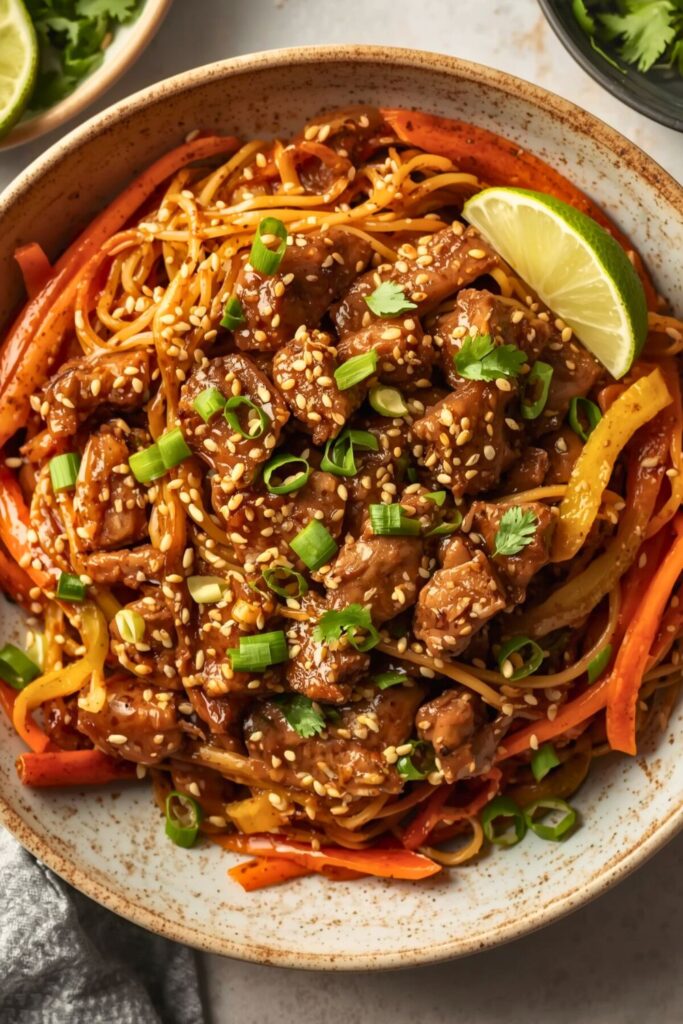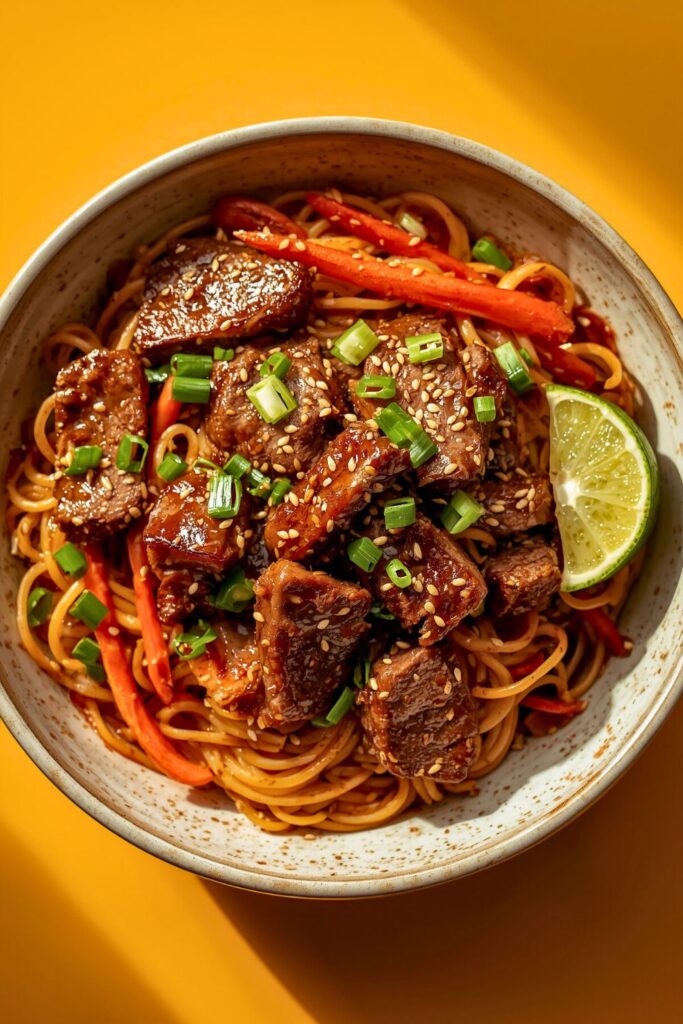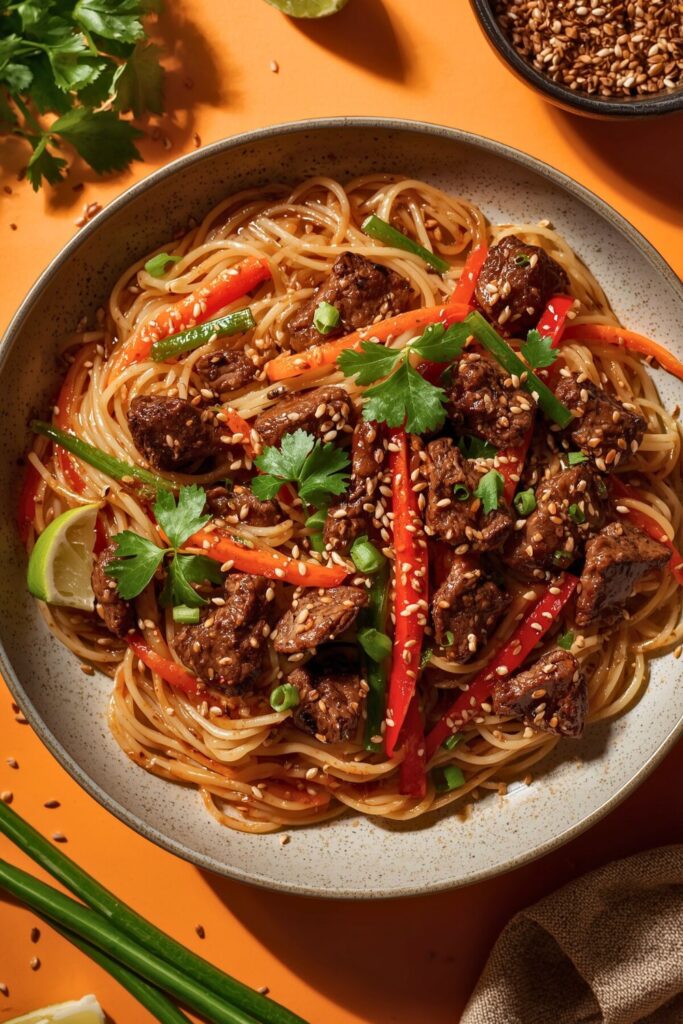Picture this: you walk into a Korean restaurant and that incredible aroma hits you, savory beef mingling with nutty sesame oil and just a hint of chili heat. Your mouth waters before you even sit down. Now imagine creating that exact same magic in your own kitchen, but better because you control every single flavor note.
That’s exactly what happens when you master Stir Fried Korean Beef And Toasted Sesame Noodles. This isn’t just another weeknight dinner, it’s your ticket to restaurant quality Korean comfort food that’ll have your family asking “seriously, you made this?”
Most people think Korean cooking is complicated. Too many ingredients they can’t pronounce, techniques that seem impossible to nail. But here’s the thing, this dish breaks all those rules. It’s built on simple techniques that create complex flavors, and once you understand the foundation, you’ll be improvising like a pro.
The real secret? It’s all about building layers of umami and getting that perfect balance between sweet, salty, and just enough heat to wake up your taste buds. Plus, those toasted sesame noodles aren’t just a side dish, they’re the foundation that soaks up every drop of that incredible sauce.
What Makes This Korean Beef Recipe Special

Let me tell you why this particular combination is gonna change your dinner game forever.
First, we’re using a technique called “velvet marinading” that most home cooks never learn. You coat thin beef slices in a mixture that includes a tiny bit of cornstarch and egg white. Sounds fancy, but it’s stupidly simple and creates the most tender, silky beef you’ve ever tasted. The proteins stay juicy even when you’re cooking over high heat.
The toasted sesame noodles are where things get really interesting. Instead of just boiling noodles like everyone else, we’re gonna toast them first in a dry pan. This creates these incredible nutty, almost smoky flavors that regular noodles can’t touch. It’s an old Korean technique that transforms cheap wheat noodles into something that tastes like it cost three times as much.
Then there’s the sauce situation. We’re building what I call a “flavor bridge” combining traditional Korean ingredients like gochujang and soy sauce with techniques that actually work in a regular home kitchen. No hunting for twenty different condiments at specialty stores.
Essential Ingredients for Korean Beef Stir Fry
Here’s everything you need, listed in the order you’ll actually use them:
For the Beef:
- 1 pound thinly sliced ribeye or sirloin (freeze it for 30 minutes first, makes slicing way easier)
- 1 egg white
- 2 teaspoons cornstarch
- 1 tablespoon soy sauce
- 1 teaspoon sesame oil
For the Toasted Noodles:
- 8 oz fresh wheat noodles (or dried ramen noodles work great)
- 2 tablespoons sesame oil
- 1 tablespoon butter (trust me on this)
For the Stir Fry Sauce:
- 3 tablespoons soy sauce
- 2 tablespoons gochujang (Korean chili paste)
- 1 tablespoon brown sugar
- 2 cloves garlic, minced
- 1 tablespoon rice vinegar
- 1 teaspoon fresh ginger, grated
The Supporting Cast:
- 2 green onions, sliced on the diagonal
- 1 medium onion, thinly sliced
- 2 tablespoons vegetable oil for cooking
- Sesame seeds for garnish
- Optional: bean sprouts, shredded carrots, or snap peas
Smart Ingredient Swaps That Actually Work
Can’t find gochujang? Mix 1 tablespoon sriracha with 1 teaspoon tomato paste and a pinch of brown sugar. Not authentic, but it’ll give you that sweet heat you’re after.
No fresh wheat noodles? Dried ramen works perfectly, just ditch the seasoning packet. Even spaghetti can work in a pinch, though you’ll lose some of that chewy texture that makes Korean noodles special.
Ribeye too pricey? Sirloin or even flank steak work great. Just slice against the grain and keep those pieces thin. The marinade will do most of the tenderizing work for you.
Vegetarian? Skip the beef entirely and double up on mushrooms. Shiitake and king oyster mushrooms have that meaty umami that makes this dish work. Or try firm tofu, just press it well and cut it into strips.
Mastering the Korean Beef Stir Fry Technique

This is where the magic happens, and honestly, it’s easier than you think.
Start with your beef prep. This marinade isn’t just about flavor, it’s about texture. When you coat those beef strips with egg white and cornstarch, you’re creating a protective barrier that keeps the proteins tender even when they hit screaming hot oil. Mix everything gently with your hands. Don’t overthink it.
Let that marinate while you prep everything else. And I mean everything, this dish moves fast once you start cooking.
Getting Those Noodles Perfect
Here’s where most people mess up. They boil the noodles first, then try to add flavor later. We’re doing the opposite.
Heat a large dry pan or wok over medium heat. Add your noodles, yeah, completely dry noodles, and toast them until they start turning golden and smell nutty. Takes about 3-4 minutes and you’ll hear them start to crackle a bit.
Now add just enough water to barely cover them. Add a pinch of salt and let them cook until tender. Drain them but save some of that starchy cooking water, you might need it later.
Toss the hot noodles with sesame oil and that tablespoon of butter while they’re still steaming. The butter melts into the noodles and creates this incredible richness that pure sesame oil alone can’t achieve.
The Stir Fry Dance
Mix all your sauce ingredients in a small bowl. Seriously, do this first. Once you start cooking, there’s no time to be measuring and mixing.
Heat your wok or largest skillet until it’s smoking hot. Add a tablespoon of oil and immediately add your beef in a single layer. Don’t move it for at least 30 seconds, let it get a proper sear.
Stir it around for another minute until just cooked through, then remove it to a plate. Don’t overcook it now because it’s going back in the pan later.
Add another bit of oil and throw in your onions. They should sizzle immediately. Cook them until they’re starting to caramelize around the edges but still have some bite.
Add your garlic and ginger for about 30 seconds until fragrant, then pour in that sauce mixture. It should bubble and reduce quickly.
Toss the beef back in along with your cooked noodles. Everything gets coated in that glossy sauce. Add a splash of that reserved noodle water if things look too thick.
The Science Behind Perfect Korean Flavors
Here’s what’s actually happening when you follow these steps, and why it matters for your final dish.
That cornstarch marinade creates what food scientists call a “velveting” effect. The proteins in the egg white denature and form a protective coating around each piece of beef. Meanwhile, the cornstarch absorbs moisture and creates an almost invisible barrier that prevents overcooking. It’s the same technique high end Chinese restaurants use.
Toasting the noodles first triggers the Maillard reaction, the same chemical process that makes bread crusts golden and gives coffee its complex flavors. You’re essentially creating hundreds of new flavor compounds that wouldn’t exist if you just boiled plain noodles.
The sauce balance is pure chemistry too. Gochujang brings fermented complexity and heat, soy sauce adds glutamates (natural MSG), brown sugar provides caramelization, and vinegar brightens everything while helping emulsify the fats. Each ingredient has a specific job.
Why This Method Works Better Than Others
Most stir fry recipes tell you to cook everything together at once. That’s a mistake because different ingredients need different temperatures and timing. By cooking the beef first, you get proper browning without overcooking. The onions get their turn to caramelize without turning mushy.
The sauce goes in when the pan is hottest so it reduces and concentrates quickly instead of making everything watery. These little details make the difference between good and restaurant quality results.
Your wok or pan temperature matters more than most people realize. Too low and everything steams instead of searing. Too high and the outside burns before the inside cooks. That sweet spot where oil shimmers but doesn’t smoke? That’s your target zone.
Making It Beautiful and Absolutely Delicious

Presentation matters, even for weeknight dinners. But we’re not talking about fancy plating, just simple tricks that make everything look intentional.
Serve this in warmed bowls if you have them. Hot food in cold bowls loses heat too quickly. Garnish with those sliced green onions and a generous sprinkle of sesame seeds. The contrast of colors makes everything pop.
A tiny drizzle of extra sesame oil right before serving adds both shine and aroma. Don’t go crazy, just a few drops around the edge of each bowl.
Perfect Pairings for Your Korean Feast
This dish is rich and satisfying on its own, but a few simple additions turn it into a complete meal. Kimchi is the obvious choice, that fermented tang cuts through the richness beautifully. Even store bought kimchi works great.
For drinks, Korean beer like Hite or Cass is traditional, but honestly? A crisp white wine like Riesling or even a light red like Pinot Noir complement those umami flavors perfectly.
Want to make it a bigger spread? Add some simple steamed vegetables, broccoli, bok choy, or snap peas all work great. Or try some Korean cucumber salad for crunch and freshness.
Bringing It All Together: Your New Go To Recipe
The beautiful thing about mastering Stir Fried Korean Beef And Toasted Sesame Noodles is that once you understand the technique, you can riff on it endlessly. More vegetables, different proteins, adjusted heat levels, it all works within this framework.
Your biggest win here is learning to build flavors in layers instead of just dumping everything together and hoping for the best. That beef marinade, those toasted noodles, the carefully balanced sauce, each element contributes something specific to the final dish.
The timing might feel tricky the first time, but after making this twice, you’ll have the rhythm down. Everything comes together in about 20 minutes once you start cooking, making this perfect for busy weeknights when you want something special without the stress.
Keep that sauce recipe handy because it works on everything from simple scrambled eggs to grilled chicken. The toasted noodle technique? Game changer for ramen, pasta, even rice noodles.
Most importantly, don’t be afraid to make it your own. Korean cooking is all about adjusting flavors to your taste. More heat? Add extra gochujang. Want it sweeter? Bump up the brown sugar. That’s how you turn a good recipe into your signature dish.
Frequently Asked Questions
Can I prep this Stir Fried Korean Beef And Toasted Sesame Noodles ahead of time?
Absolutely, but with some smart strategies. Marinate your beef up to 4 hours ahead, any longer and the enzymes start breaking down the texture too much. Toast your noodles and store them covered at room temperature for up to a day. Mix your sauce and keep it in the fridge for up to a week. Just remember, the actual stir frying needs to happen right before serving for best results.
What’s the best cut of beef for stir frying?
Ribeye gives you the most flavor and stays tender even if you slightly overcook it, but it’s pricey. Sirloin is my everyday choice, great flavor, reasonable price, and it marinates beautifully. Flank steak works too if you slice it paper thin against the grain. Avoid lean cuts like eye of round, they’ll turn tough no matter how you cook them.
My sauce turned out too salty/sweet/spicy, how do I fix it?
Too salty? Add a bit more brown sugar and a splash of rice vinegar. Too sweet? Balance it with extra soy sauce and a squeeze of lime. Too spicy? Stir in a spoonful of peanut butter or add more noodles to dilute the heat. The beauty of stir fry is that you can always adjust as you go.
Can I make this gluten free?
Sure thing! Use tamari instead of soy sauce and rice noodles instead of wheat noodles. Skip the toasting step with rice noodles though, just soak them according to package directions. You might need to add a bit more sauce since rice noodles don’t absorb flavors quite as well as wheat noodles.
Why do my vegetables always turn out mushy in stir fry?
You’re probably adding them all at once or using too low heat. Add harder vegetables like onions and carrots first, then softer ones like bell peppers, and finally delicate stuff like bean sprouts right at the end. Keep that heat high and don’t overcrowd your pan, cook in batches if you need to.

Swiftly Captions by Tina Smith — Quick, flavorful food recipes made simple, bringing fresh inspiration to your kitchen every day






